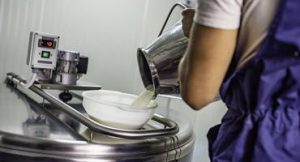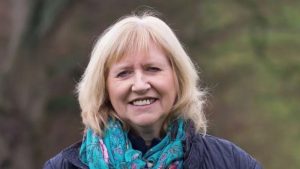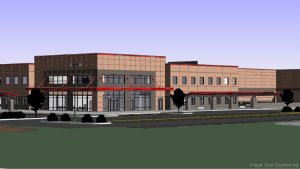
Making improvements to your farm often involves balancing a positive outcome against the cost and effort involved. During its time as an AHDB strategic farm, high-yielding Yorkshire farm Willow Tree has been tackling mastitis cases while managing resources and trying not to reduce the amount of milk produced.
Home to an all-year-round calving herd of 280 fully housed Holstein-Friesian cows, Willow Tree Farm is located near Northallerton in North Yorkshire. Farmed by the Pattison family, including Howard and son Tom, it extends over 162 ha and achieves an average annual yield of 13,500 L per cow at 4.2% butterfat and 3.4% protein.
They joined AHDB’s Strategic Dairy Farm (SDF) programme in 2022, averaging 12,500 L per cow, using high genetic index sires. Subsequently, various changes were made, including working with Arla to reduce their carbon footprint and changing feed from soy meal.
The three-year SDF programme is driven by farmers for farmers, using open meetings to help levy payers share knowledge and learn from one another, as well as offering support from industry leaders. The objective is to expose different methods and give farmers the confidence to explore new ideas and adopt change in their own businesses. Working with their local Knowledge Exchange Manager, each farm identifies particular challenges and sets goals within the context of its local environment.
When asked about the Strategic Dairy Farm programme, Tom said:
“We applied to join the Strategic Dairy Farm programme after talking to Alan McFadzean, Dairy Knowledge Exchange Manager. Eighteen months ago, he outlined some of the benefits for us, including having access to industry specialists. After joining, we got together with Alan and set some goals for the three-year programme.
“We have benefited by getting extra help, support and knowledge from the meetings. We get advice from many people, including industry experts and other like-minded farmers. I got talking to a couple of farmers, and ideas got thrown around.”
At Willow Tree Farm, the Pattisons’ primary focus had been on addressing mastitis, identified as the biggest challenge on their farm due to their highly productive herd. They also explored recent advancements in the use of slurry and fertiliser, with an emphasis on better nitrogen utilisation and reducing fertiliser usage.
When asked about the changes and developments they had made, Tom said:
“Since entering the programme, we have started doing more soil samples, looking at variable rate spreading and also testing the slurry to make sure we know what key nutrients are available in our slurry.”
Working with vet James Breen, the changes to address mastitis successfully reduced the total number of cases by 40%. One of the most significant changes was merging two groups of milking cows into one by opening up four sheds, which provided the cows with additional space.
Tom and his family also transformed an empty area next to the parlour into an extra collecting yard. This allowed for the relocation of the footbath, enabling the cows to pass through it twice a day after leaving the parlour. Keeping the yard open between milking times increased the available loafing space by 2.6 sq m per cow.
Tom explained that he and his team had changed their bedding sand to a larger-grained variety to reduce compaction on the beds. Despite regular digging, the beds were becoming hard and black underneath. After switching to the new sand, they conducted multiple bacteriology tests, which showed results that were better than or at least as good as average. The new sand also eliminated the need to dig out the beds entirely, as they now only add more sand when needed, saving significant time and cost.
Tom noted that while their cell count dropped dramatically, this led to another issue: an increase in cases of toxic E. coli mastitis, resulting in the loss of a few cows. To address this, he has been working with James Breen from Map of Ag to reduce the use of antibiotic tubes. A mastitis vaccination programme has been implemented, though he remarked that it is still too early to determine its effectiveness.
When asked about future topics, Tom said:
“Ventilation wasn’t really mentioned as one of the goals when we first started the programme. Our first year suffered the very hot summer and we saw temperatures of 35–36 degrees. Ventilation was mentioned by one of the farmers on our open day, and this set the ball in motion.
“The cows were starting to bunch up more and they preferred different sheds at different times of the year. There is plenty of airspace and it is the quite airy to start with, but with the cows bunching, it showed us that maybe there was an issue.”
Temperature humidity sensors were installed, so they could start by assessing the temperature and humidity in different places in the sheds to help them find the best solution. There are a lot of different options for increasing air flow, and the Pattisons want to be sure they are doing the right thing. Work has started by installing ventilation tubing in one of the calf houses, and they are considering a complete revamp.
Future aspirations
The Pattisons will meet James Breen again to review their mastitis cases, actions and whether the work they have done has reduced the cases of E. coli mastitis. They are hoping to see good results from the milk recordings and mastitis case data.
Over the next year, they will focus on improving the shed ventilation based on their monitoring of temperature and humidity.
You can now read the most important #news on #eDairyNews #Whatsapp channels!!!
🇺🇸 eDairy News INGLÊS: https://whatsapp.com/channel/0029VaKsjzGDTkJyIN6hcP1K

























